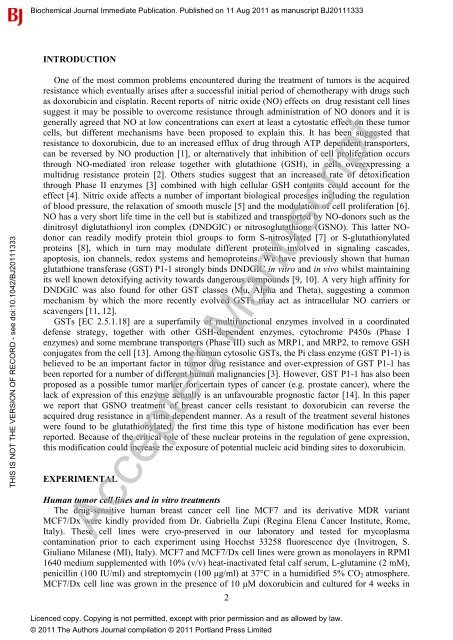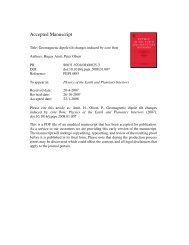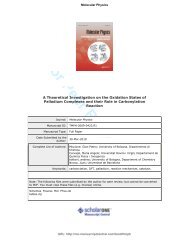1 TREATMENT OF DOXORUBICIN RESISTANT MCF7/Dx ... - TARA
1 TREATMENT OF DOXORUBICIN RESISTANT MCF7/Dx ... - TARA
1 TREATMENT OF DOXORUBICIN RESISTANT MCF7/Dx ... - TARA
Create successful ePaper yourself
Turn your PDF publications into a flip-book with our unique Google optimized e-Paper software.
Biochemical Journal Immediate Publication. Published on 11 Aug 2011 as manuscript BJ20111333<br />
INTRODUCTION<br />
THIS IS NOT THE VERSION <strong>OF</strong> RECORD - see doi:10.1042/BJ20111333<br />
One of the most common problems encountered during the treatment of tumors is the acquired<br />
resistance which eventually arises after a successful initial period of chemotherapy with drugs such<br />
as doxorubicin and cisplatin. Recent reports of nitric oxide (NO) effects on drug resistant cell lines<br />
suggest it may be possible to overcome resistance through administration of NO donors and it is<br />
generally agreed that NO at low concentrations can exert at least a cytostatic effect on these tumor<br />
cells, but different mechanisms have been proposed to explain this. It has been suggested that<br />
resistance to doxorubicin, due to an increased efflux of drug through ATP dependent transporters,<br />
can be reversed by NO production [1], or alternatively that inhibition of cell proliferation occurs<br />
through NO-mediated iron release together with glutathione (GSH), in cells overexpressing a<br />
multidrug resistance protein [2]. Others studies suggest that an increased rate of detoxification<br />
through Phase II enzymes [3] combined with high cellular GSH contents could account for the<br />
effect [4]. Nitric oxide affects a number of important biological processes including the regulation<br />
of blood pressure, the relaxation of smooth muscle [5] and the modulation of cell proliferation [6].<br />
NO has a very short life time in the cell but is stabilized and transported by NO-donors such as the<br />
dinitrosyl diglutathionyl iron complex (DNDGIC) or nitrosoglutathione (GSNO). This latter NOdonor<br />
can readily modify protein thiol groups to form S-nitrosylated [7] or S-glutathionylated<br />
proteins [8], which in turn may modulate different proteins involved in signaling cascades,<br />
apoptosis, ion channels, redox systems and hemoproteins. We have previously shown that human<br />
glutathione transferase (GST) P1-1 strongly binds DNDGIC in vitro and in vivo whilst maintaining<br />
its well known detoxifying activity towards dangerous compounds [9, 10]. A very high affinity for<br />
DNDGIC was also found for other GST classes (Mu, Alpha and Theta), suggesting a common<br />
mechanism by which the more recently evolved GSTs may act as intracellular NO carriers or<br />
scavengers [11, 12].<br />
GSTs [EC 2.5.1.18] are a superfamily of multifunctional enzymes involved in a coordinated<br />
defense strategy, together with other GSH-dependent enzymes, cytochrome P450s (Phase I<br />
enzymes) and some membrane transporters (Phase III) such as MRP1, and MRP2, to remove GSH<br />
conjugates from the cell [13]. Among the human cytosolic GSTs, the Pi class enzyme (GST P1-1) is<br />
believed to be an important factor in tumor drug resistance and over-expression of GST P1-1 has<br />
been reported for a number of different human malignancies [3]. However, GST P1-1 has also been<br />
proposed as a possible tumor marker for certain types of cancer (e.g. prostate cancer), where the<br />
lack of expression of this enzyme actually is an unfavourable prognostic factor [14]. In this paper<br />
we report that GSNO treatment of breast cancer cells resistant to doxorubicin can reverse the<br />
acquired drug resistance in a time dependent manner. As a result of the treatment several histones<br />
were found to be glutathionylated, the first time this type of histone modification has ever been<br />
reported. Because of the critical role of these nuclear proteins in the regulation of gene expression,<br />
this modification could increase the exposure of potential nucleic acid binding sites to doxorubicin.<br />
EXPERIMENTAL<br />
Human tumor cell lines and in vitro treatments<br />
The drug-sensitive human breast cancer cell line <strong>MCF7</strong> and its derivative MDR variant<br />
<strong>MCF7</strong>/<strong>Dx</strong> were kindly provided from Dr. Gabriella Zupi (Regina Elena Cancer Institute, Rome,<br />
Italy). These cell lines were cryo-preserved in our laboratory and tested for mycoplasma<br />
contamination prior to each experiment using Hoechst 33258 fluorescence dye (Invitrogen, S.<br />
Giuliano Milanese (MI), Italy). <strong>MCF7</strong> and <strong>MCF7</strong>/<strong>Dx</strong> cell lines were grown as monolayers in RPMI<br />
1640 medium supplemented with 10% (v/v) heat-inactivated fetal calf serum, L-glutamine (2 mM),<br />
penicillin (100 IU/ml) and streptomycin (100 μg/ml) at 37°C in a humidified 5% CO 2 atmosphere.<br />
<strong>MCF7</strong>/<strong>Dx</strong> cell line was grown in the presence of 10 μM doxorubicin and cultured for 4 weeks in<br />
Accepted Manuscript<br />
2<br />
Licenced copy. Copying is not permitted, except with prior permission and as allowed by law.<br />
© 2011 The Authors Journal compilation © 2011 Portland Press Limited
















